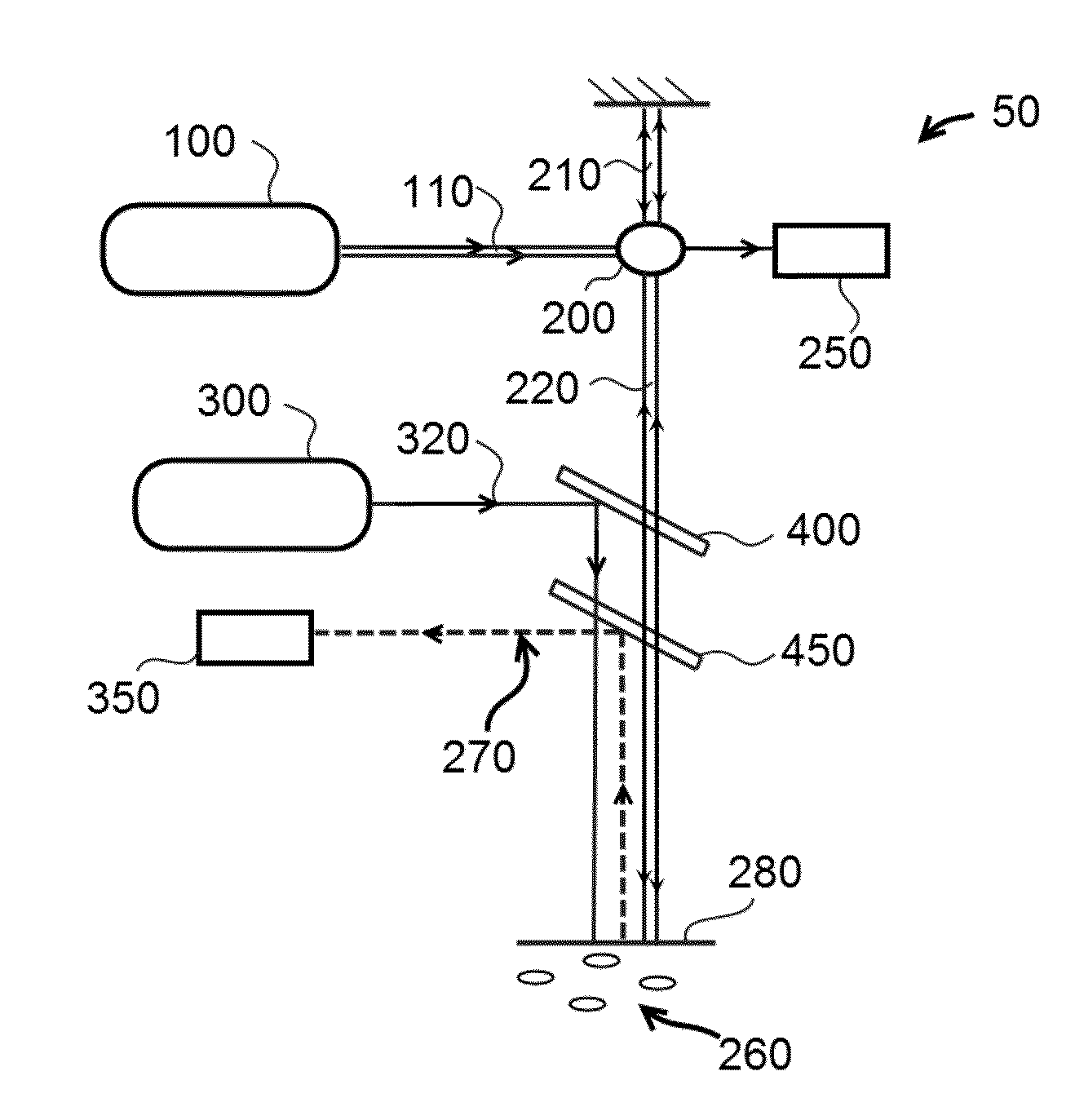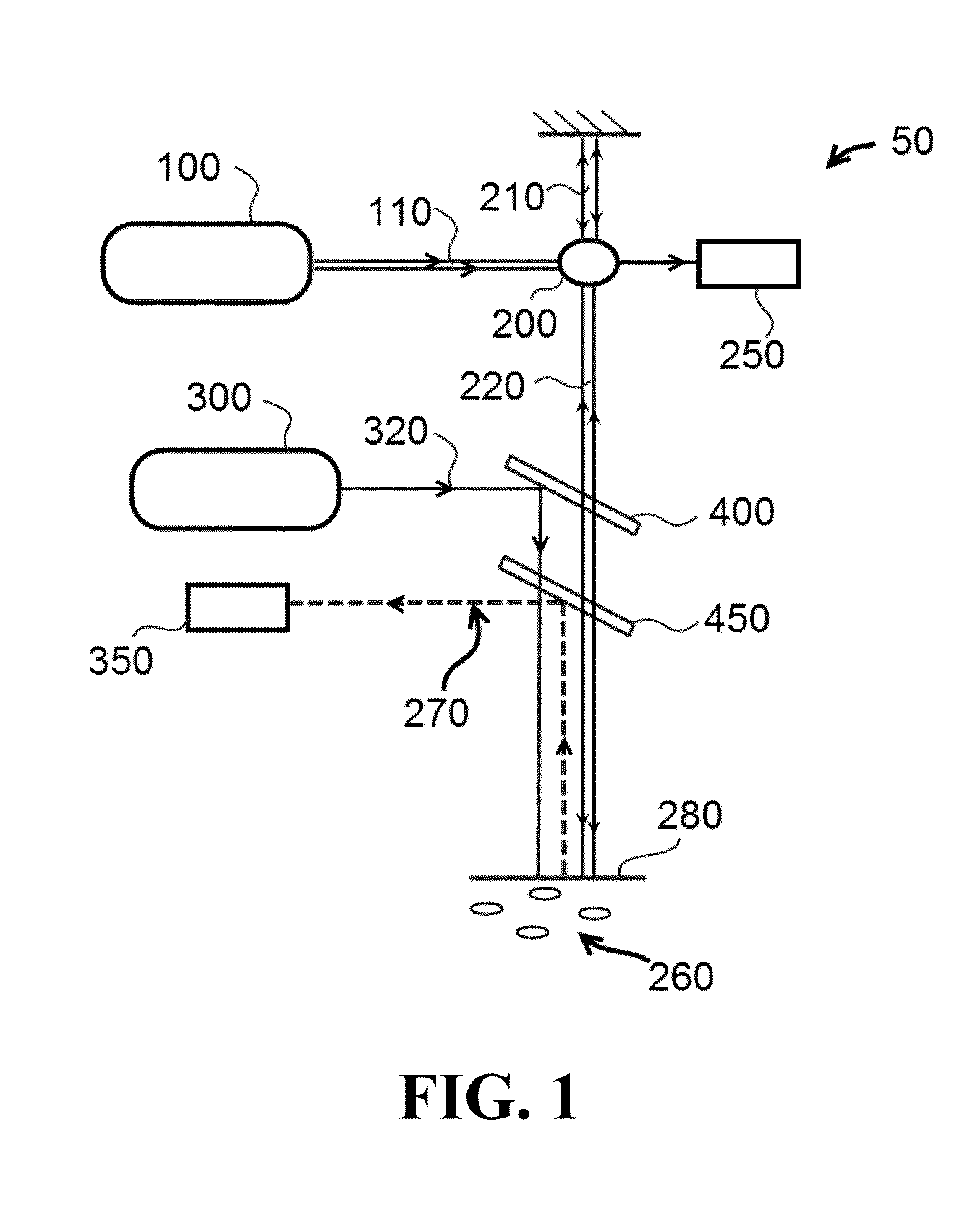Apparatus and methods for optical coherence tomography and two-photon luminescence imaging
a technology of optical coherence tomography and luminescence imaging, applied in the field of apparatus and methods for optical coherence tomography and twophoton luminescence imaging, can solve the problems that the risk of plaque rupture cannot be easily assessed by only ivoct images, and the combination of fiber-based oct-tpl systems has not been previously realized, and achieves high spatial resolution
- Summary
- Abstract
- Description
- Claims
- Application Information
AI Technical Summary
Benefits of technology
Problems solved by technology
Method used
Image
Examples
example 1
Catheter-Based Intensity OCT-TPL System
[0064]Examples of the catheter-based intensity OCT-TPL system (shown in FIGS. 5A and 5B) can incorporate a spectral-domain OCT system operating at 1310 nm combined with TPL using a tunable femtosecond laser excitation (e.g., 760-1040 nm, 6 nJ-5 μJ, 100 fs-1 ps, 500 kHz-80 MHz). A pulse compressor can be utilized to pre-compensate the group dispersion delay of femtosecond laser light to provide transform-limited pulses on the luminal surface. The imaging catheter is connected to a photonic crystal fiber (PCF) (e.g., LMA-20, NKT Photonics) of the OCT-TPL imaging system, which can enable single-mode propagation of both OCT light and TPL excitation light and transmission of TPL emission light (e.g. the OCT light and TPL excitation light are transmitted simultaneously). In certain embodiments, the PCF may comprise a 15 μm core (e.g., LMA-15).
[0065]FIG. 5A depicts a catheter-based intensity OCT-TPL imaging system comprising a beam splitter (BS); band...
example 2
Catheter-Based Polarization-Sensitive OCT-TPL System
[0071]One example of the catheter-based polarization-sensitive OCT-TPL system (shown in FIG. 6) can incorporate a spectral-domain polarization-sensitive OCT (PSOCT) system operating at 1310 nm combined with TPL using a tunable femtosecond laser excitation (e.g., 760-1040 nm, 6 nJ-5 μJ, 100 fs-1 ps, 500 kHz-80 MHz). The system in FIG. 6 comprises polarization maintaining fiber segments (PM1 and PM2) that act as an in-line fiber polarimeter; a polarization beam splitter (PBS); a band-pass filter (BP); a short-pass filter (SP); a photon multiplier tube (PMT); and a photonic crystal fiber (PCF).
[0072]The PSOCT system utilizes balanced detection and an in-line fiber polarimeter [29] to measure the polarization state of both reference light and interference fringes. An open optical switch in the sample path of the interferometer allows measurement of a signal containing only the polarization state of reference light (without interference...
example 3
Catheter-Based Spectral Domain Phase-Sensitive OCT-TPL System
[0073]One example of a catheter-based phase-sensitive OCT-TPL system (shown in FIG. 7) can incorporate a spectral-domain phase-sensitive OCT (PhSOCT) system operating at 1310 nm combined with TPL using a tunable femtosecond laser excitation (e.g., 760-1040 nm, 6 nJ-5 μJ, 100 fs-1 ps, 500 kHz-80 MHz). The system of FIG. 7 comprises a polarization beam splitter (BS); a band-pass filter (BP); a short-pass filter (SP); a photon multiplier tube (PMT); and a photonic crystal fiber (PCF).
[0074]A pulse compressor can be utilized to pre-compensate the group delay dispersion of femtosecond laser light to provide transform-limited pulses incident on the luminal surface of the vessel being imaged. The imaging catheter can be connected to a photonic crystal fiber (PCF) (e.g., LMA-20, NKT Photonics) of the OCT-TPL imaging system, which can enable single-mode propagation of both OCT light and TPL excitation light and transmission of TPL ...
PUM
 Login to View More
Login to View More Abstract
Description
Claims
Application Information
 Login to View More
Login to View More - R&D
- Intellectual Property
- Life Sciences
- Materials
- Tech Scout
- Unparalleled Data Quality
- Higher Quality Content
- 60% Fewer Hallucinations
Browse by: Latest US Patents, China's latest patents, Technical Efficacy Thesaurus, Application Domain, Technology Topic, Popular Technical Reports.
© 2025 PatSnap. All rights reserved.Legal|Privacy policy|Modern Slavery Act Transparency Statement|Sitemap|About US| Contact US: help@patsnap.com



